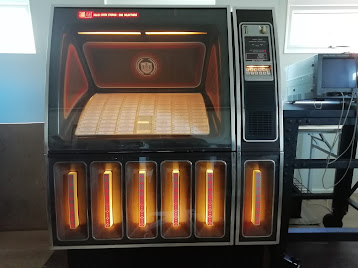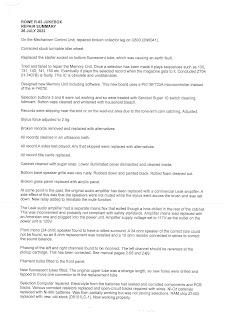BBC Radio Solent Interviews at our December 2023 Event
Both volunteers and visitors had a surprise when they were interviewed by BBC Radio Solent’s Annie at our December 9 2023 event. Here are a few ‘soundbytes’ from those interviews.

Ros, you are in your Christmas get-up and I can see that a lot of other
people are as well. I am in my Mummy
Christmas outfit with my halo on…. Sometimes, you don’t have to give new. You
can give someone a lovely present by getting something repaired for them,
something that they treasure.
I’m Dave I’ve got a Santa that needs fixing. How long have you had the Santa? It doesn’t look like the newest thing. It got it from my Grandad. It’s 20-30 years old. It sings “Jinglebell Rock” and shakes its hips. But not at the moment. If we get him undressed... Cover your eyes. <John> We’ve got to get to the circuitry now. Take the feet off. We’ve got to undress him a little bit unfortunately. Fingers crossed… Father Christmas has got his trousers down and his back open. What’s happening now? We are just trying to fault find. We’ve got power to the unit. We are just trying to see where the circuit has got power. It might be a little cable. The test is to take the whole thing apart.
I’m Victoria, I live in Weymouth and I’ve bought a bear to be repaired. Rose, one of my daughters was poorly in hospital and she got the bear as a present to help her through the time that she was not feeling very well. He’s lost his voice so he can’t speak any more and he used to sing. His name is Bingo Bear. It’s probably our fault. We’ve torn something apart and it needs soldering. Hopefully, he’ll sing again.
Kevin here looks like he’s doing a fantastic job. How did you get into fixing stuff like this? I am actually a military aircraft designer. I’ve been designing fighter aircraft since 1976. I helped to design the Eurofighter, ejection sheets, NASA, Boeing aircraft, in-flight refuelling … so engineering has been my whole life. So this is a piece of cake compared to what you have been doing before. 😊
My name is Tara Charlton. I’m hoping to get a Christmas
decoration fixed – the battery-operated motor part of the snowman. I think I’ve
had it about 8-9 years. When you switch it on it lightsup. It’s just nostalgia
for me. My boys were quite young when I first bought it and they loved it.
That is very quick. I’m delighted. He’s mended it. It’s got a new elastic
band on. That’s brilliant. Are you pleased Mike? I am pleased. I hate it
when bits of technology do not come apart in a nice easy manner. So where is
it going to go now that you’ve got it fixed and ready? It sounds really odd
but it’s going in my little window sill in my kitchen so when I’m doing my
boring dishes, which I hate, I’ve got something really nice to look at going
round. 😊
I’m Phil from the Repair Café. It might only be something
small and ‘tat’ to somebody else but to them, it’s either from a loved one or someone
who has passed away and it’s a memory of them. It’s about watching their
reaction once you either press a button or wind it up or whatever you do to it.
In fact, it’s making me a bit emotional just thinking about what I have seen
through this. I just think that’s a great feeling to give that to somebody. 💚
Ros Dean
6 January 2024












.jpg)
.jpg)













